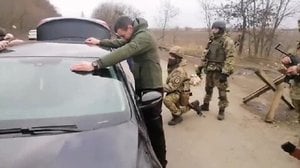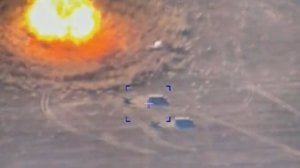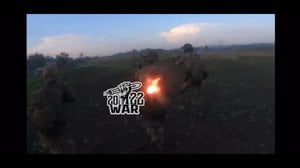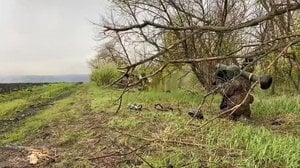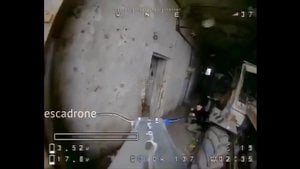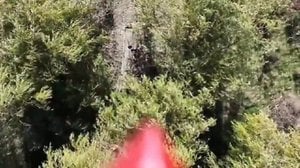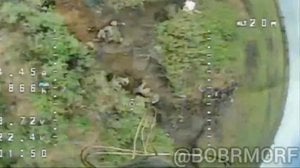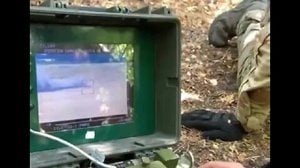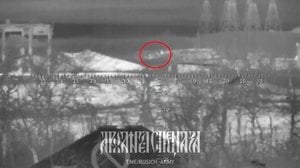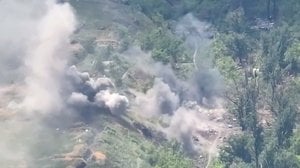
Drone Munitions and Field Fortifications
Published 1 years ago
Ukrainian footage of a drone dropping a grenade into a Russian trench. The trench is in a heavily wooded area, though the trees have been stripped of their greenery by shellfire, and though the trench is narrow, it lacks overhead cover. The drone hovers a moment above two soldiers barely visible in the trench, and then drops a grenade between them. The explosion provokes an immediate reaction. The soldiers in the trench tuck back into a more protected area, presumably attending to the wounded.
I usually do not post these videos of drone-dropped munitions. At this point in the conflict, we are aware of the capability, and watching oblivious draftees blasted by grenades and mortar rounds over an over seems a little twisted. However, this does offer an opportunity to discuss fighting positions and field fortifications. When I entered active duty, much of our training was based on Cold War doctrine. We dug fighting positions in training, though there was no realistic expectation of encountering a legitimate air threat, and for the most part static defensive positions did not mesh with the Marine Corps’ offensive warfighting philosophy. During the march on Baghdad in 2003 we were supposed to dig fighting positions near our vehicles during long halts, but our halts were rarely long, and effective IDF was rarely encountered so we eventually abandoned the practice. For most of the veterans and service members who came of age conducting counterinsurgency (COIN) operations in Iraq or Afghanistan, digging fighting positions was an episode experienced in basic training or infantry school and soon forgotten.
However, like acid washed jeans, fascism, and wars of empire, what is old is now new, and old practices will once again be in vogue. Both sides in the war in Ukraine have constructed extensive field fortifications consisting of dugouts, trenches, and crew-served weapons positions. Many of the Russian trenches and dugouts seen in footage posted on Funker530 have been deep and seem to offer protection from direct fire systems as well as traditional IDF systems. Though mortars and artillery can effectively suppress prepared defenses, a direct hit is usually required to eliminate the occupants, and the damage is often localized to the section of the trench struck by fire. While many of the dugouts shown provide overhead protection, they do not allow the occupants to fight effectively, and though the trench systems allow the occupants to engage approaching enemy troops, many of trenches shown in footage have little overhead protection. Furthermore, IDF systems, helicopters, and planes are no longer the only threat from above. Small, off the shelf drones, modified to carry munitions and, in some cases, with thermal sensors, have become a threat which both sides struggle to counter and that seem to negate many of the advantages afforded by traditional fighting positions. While their effects are not immediately catastrophic, drone-delivered munitions are certainly disruptive, have the ability to neutralize point targets or critical equipment, and are undoubtedly corrosive to morale.
While technology will certainly emerge to counter the drone threat, for the time being certain simple practices could mitigate the effectiveness of this drone munitions. The first is improved overhead cover. Many of the Russian trenches seen in the videos posted on this site lack any kind of overhead cover, though there are plenty of materials nearby which might provide it. Branches, tree trunks, lumber, and layers of earth can offer protection from heavier artillery and rockets, by plywood, chicken wire, and other materials can deflect smaller munitions dropped from quad copters. In 1944, British troops in the shattered town of Casino occupied positions that, in some cases, were only a few meters from the enemy, and they screened their foxholes in chicken wire to deflect grenades. Another older practice is that of assigning an air sentry. Just as soldiers provide security to the front, flanks, and rear, an air sentry provides dedicated eyes on the sky to provide early warning for incoming air threats. A practice initially adopted during World War II, assigning an air sentry was still prescribed by manuals when I entered active duty, though it was never practiced.
Ultimately drones and drone-delivered munitions will change the way that modern infantry and mechanized units fight, and new tactics, techniques, and procedures will be developed while old ones may need to be dusted off and put back into play. Digging slit trenches next to tanks and armored vehicles was a practice for crews fighting in North Africa in 1942 and 1943, offering a quick escape when Luftwaffe raiders pounced from above. It may be that this practice may need to be revived, along with a form of light, portable, yet strong overhead protection that can be rapidly deployed over slit trenches and vehicle hatches. Of course, none of these measures can protect from FPV drones, but perhaps the small, portable anti-aircraft gun should also make a comeback in one form or another. One thing is certain – doing nothing is not a very good answer, and as long as soldiers hang about in trenches with minimal overhead cover and limited situational awareness, it will continue to rain grenades.
About the Author

Cam
Cam served as an infantry officer in the Marine Corps, deploying to the Horn of Africa and participating in combat operations in Iraq. He currently works in the maritime industry and in the defense sector as an instructor of combined arms planning and operations. An avid sailor, Cam founded and directs Triumph Sailing, a nonprofit that supports veterans and first responders through adventure and fellowship on the water. Triumph Sailing is preparing for its big yearly event, an offshore race in the Gulf of Mexico with an all veteran crew. You can support the mission at Tri-Sail.Org.



